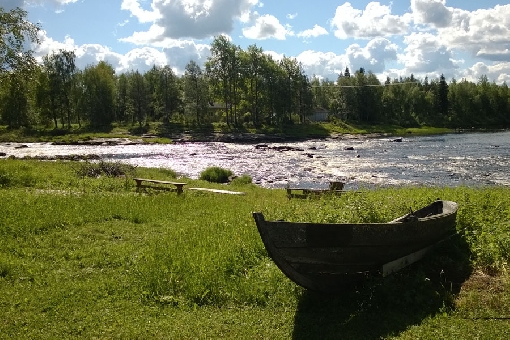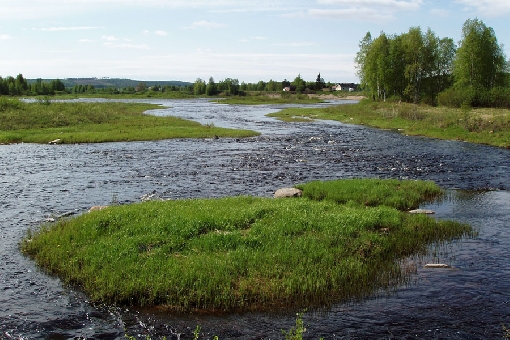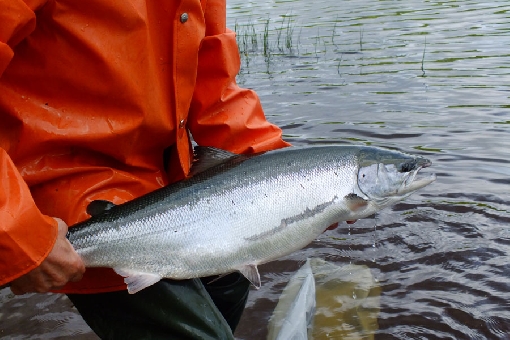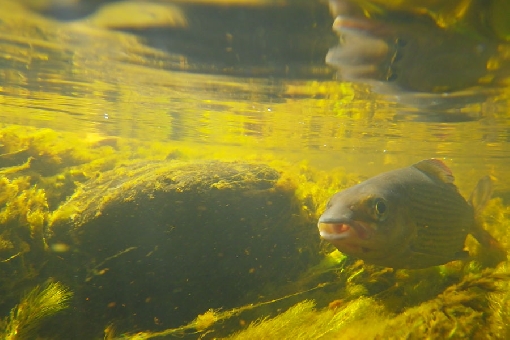River Iijoki - well-stocked waters and riverside culture
Photo: M. Niskasaari The gliding peace of River Iijoki.
River Iijoki streams through the Finnish landscape with its magnificent rapids and meandering spawning areas, originating from the limpid lakes of the north-eastern Koillismaa region and discharging its waters into the Bothnian Bay at the Ii municipal centre. Over the 370-kilometre journey of the main river channel, the level difference of 250 metres shapes a diverse flowing-water environment for a wide variety of species.River Iijoki’s native stocks of migratory fish have been preserved successfully, despite the five power plant dams located along the route. Trout (Salmo trutta), grayling (Thymallus thymallus), whitefish (Coregonus lavaretus) and salmon (Salmo salar) are the most sought-after catches in River Iijoki. Photo: T. Mahosenaho  The Kynkäänkoski Rapids in River Livojoki, a tributary of River Iijoki. River Iijoki and fishing areas The upper sections of the handsome River Iijoki mostly run through sparsely populated, majestic hill sceneries, adorning the ‘waist of the Maiden of Finland’, as the narrow mid-section of the country is referred to. This is the starting point for a 20-kilometre rapids fishing site, covering 22 rapids or torrents with grayling and trout habitats. Moving downstream, the banks of the water body are graced with low-lying meadows and riverside villages, offering genuine cultural sights for those moving around on the water. With its numerous races, rapids and pools, the middle section fishing area of River Iijoki is 53 kilometres long. The most common game species are grayling and trout in fast-flowing stretches and pike in slow-flowing pools. The Kipinänkosket Rapids form the longest continuous stretch of rapids in River Iijoki, running for a distance of 10 kilometres. In addition to fishing, the site is excellent for canoeing and hiking. About 60 kilometres from the City of Oulu lies the Kipinänkosket Rapids Fishing Resort. The Korvuanjoki–Näljänkäjoki combined licence area covers 110 km of fishing waters in River Iijoki and its tributaries, Rivers Korvuanjoki and Näljänkäjoki. Fishing in the area is based on natural stocks, such as grayling as well as trout in some places. There are more than 60 rapids sites. Several sites are within easy reach by car. Photo: Metsähallitus  A habitat for young fish in the Kurjenkoski Rapids. If you are looking for a beautiful wilderness, why not head to the limpid River Livojoki, a tributary of River Iijoki. The river offers fishing spots over a distance of about 40 kilometres. Just like on River Iijoki, there are also cultural landscapes along the Livojoki riverside, such as the Lake Aittojärvi Kyngäs Village, which is classified as a nationally valuable landscape area. In addition to the above-mentioned fishing sites, River Iijoki tributaries also provide other fishing opportunities, such as River Pärjänjoki recreational fishing site and Kovalampi Pond. Further information on all of the above fishing sites, including campfire sites and resting places, fishing licences and maps, is available in Finnish and English at https://iijoenvesilla.fi. Towards the lower reaches of River Iijoki, at the Yli-Ii district of Oulu, lies a stone-age village called Kierikki. The district’s snowfall is among the highest in Finland, with considerable floods in the springtime, and the lower reaches of River Iijoki have therefore been harnessed for energy production. Photo: K. Vääräniemi  A female salmon being released to spawning waters. Fishways and relocations of female salmon in River Iijoki River Iijoki plays a unique role in the region and in the entire country. There are plans to build fishways across every power plant dam in the river to allow its native migratory stocks to move freely between the river and the sea, as they did at the dawn of time. Relocations of mature female salmon across the barriers to the best spawning spots in the middle section of the river started even before fishway construction got underway. Salmon have been relocated every summer since 2009 and there is no end in sight until the fishways are finished. After decades of hiatus, the river is once more a spawning site for salmon and a starting point for smolt, or young migratory fish heading out to sea. When these young specimens are ready to head back to the river to spawn, they will be transported upriver on wheels (by lorry), as in previous years, until they can swim there on their own. Photo: M. Niskasaari  River Iijoki is home to grayling. With its tributaries, the River Iijoki water system offers well-stocked fishing grounds and splendid nature experiences with diverse opportunities for recreational fishing – spinning, fly-fishing or trolling on a boat. River Iijoki is easily accessible and its stocks of fish are strong and diverse. Its well-managed fishing grounds offer chances of making quite generous catches. The beautiful sceneries with fast-flowing waters and riverbanks make for versatile canoeing or rowing routes. The River Iijoki water system invites you to enjoy fishing and hiking in the midst of splendid natural sceneries and riverside culture! |